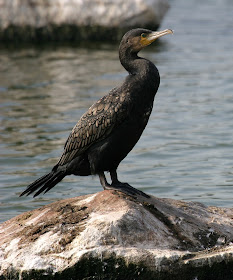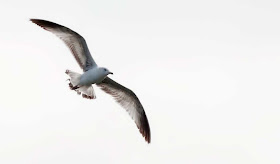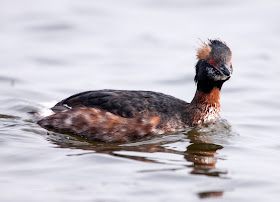I've just been reading a paper published in the Journal of Ornithology titled: "Licensed control does not reduce local Cormorant
Phalacrocorax carbo population size in winter." It's another of those scientific studies carried out into human-wildlife conflicts which, to my mind, are becoming more and more prevalent. The current proposals for a badger cull being the latest. This paper, written by D E Chamberlain, G E Austin, S E Newson, A Johnston and N H K Burton says it all, more-or-less, in the title.
Here's the thing: Cormorants
Phalacrocorax carbo have increased on inland waters in Britain causing conflicts with fishing interests - fishermen. Because of this several countries have introduced control measures; either lethal (shooting) or non-lethal (scaring the birds!). The paper states that "Human-wildlife conflicts are at the root of many current conservation problems and occur when requirements of wildlife overlap with those of human intersts." There's a surprise, I bet you could name a few in Britain alone - birds of prey, badgers, ruddy duck, fox, corvids! Measures to resolve such conflicts may include both lethal and non lethal control of wildlife. From the scarecrow to the gun. Cormorants are the source of human-wildlife conflict where their populations are increasing both due to damage to trees from guano - some fine examples of this at Attenborough Nature Reserve in west Notts - and potential impacts on fish populations.
 |
| Cormorant Phalacrocorax carbo |
"Within Europe, the Great Cormorant
Phalacrocorax carbo population has shown steep increases over the past few decades. This is particularly true of the subspecies
P. carbo sinensis which is the most numerous in the northern parts of continental Europe and has rapidly expanded its range and population." The coastal breeding subspecies,
P c. carbo has also started to move to inland freshwaters during the winter - all bad news for the fishemen and the roost trees. In the UK, in order to prevent serious damage to fisheries from Cormorant predation, licences have been made available since autumn 1996 for limited control of Cormorant populations by shooting. The authors of this paper have analysed data - particularly from WeBS (Wetland Bird Survey) Core Counts from 1988 to 2009 and in a detailed description of the methods used to collect and analyse this data stretching over half-a-dozen A4 sides come to the conclusion that~: "Based on the results here, there is no evidence that Cormorant removal at local scales has had an effect on longer term population size at a site level - put simply, killing Cormorants in one winter did not appear to impact upon numbers at a site level in the next winter."
 |
| Cormorant Phalacrocorax carbo Taken at a local Country Park - Where the fishermen fish. |
 |
| Breeding adult Cormorant Phalacrocorax carbo - Rutland Water |
The authors suggest five possible reasons why killing Cormorants at a given site does not mean a fall in population during the following winter. One - killed Cormorants are simply replaced by other birds moving in from other areas. Two - significant disturbance caused by shooting may cause dispersal which may lead to apparent population increases. Three- control was not carried out on WeBS sites and birds may have moved there for refuge. Four - licenced control may be sought in anticipation of increased Cormorant predation prior to enhanced fish stocking which attracts more Cormorants. Five - licences granted at short notice in response to local increases in Cormorant numbers would suggest that control measures are undertaken in areas with the greatest growth rates, but also that such measures do not have significant impacts on the increasing local population. All very thought provoking and stuff that adds an extra dimension when you are looking at Cormorants on your local freshwaters.

The paper concludes that "We therefore suggest that the English winter Cormorant population as measured by the Cormorant index is not negatively influenced by control measures, but we need to add the caveat that not enough is known about the population outside WeBS sites, which are poorly monitored."
What lessons can we learn from this with regards to the Badger culling?
Visit:
http://www.bto.org/volunteer-surveys/webs for information on the Wetland Bird Survey and how you can join in.



















































